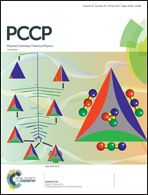Electronic structure and conformational conversion of calix[4]arene complexes with alkali metal ions†
Abstract
The ultraviolet photodissociation (UVPD) spectra of calix[4]arene (C4A) complexes with alkali metal ions, M+·C4A (M = Na, K, Rb, and Cs), are measured in the 34 000–37 000 cm−1 region under cold (∼10 K) conditions in the gas phase. The UVPD spectra of the Na+·C4A and K+·C4A complexes show several sharp vibronic bands, while the UVPD spectra of the Rb+·C4A and Cs+·C4A complexes exhibit only broad features. The UVPD spectra are assigned with the aid of quantum chemical calculations. Most of the features in the UVPD spectra can be attributed to cone isomers, which are the most stable for all the M+·C4A complexes. In all the cone isomers, the M+ ion is encapsulated inside the cavity of C4A, and the structure is distorted to C2 symmetry from that of bare C4A (C4 symmetry). The cone isomers show a big difference in the electronic structure between the K+ and Rb+ complexes. The Rb+ and Cs+ complexes have an electronic structure similar to that of bare C4A. In the Na+ and K+ complexes, the two benzene rings facing each other in a pair have a short distance between them (<6 Å). This results in a substantial overlap of the π clouds between them, and an electronic transition is localized on this pair. Only this localized electronic transition of the Na+ and K+ complexes shows sharp band features in the UVPD spectra. In the Na+·C4A complex, the UVPD spectroscopic results suggest the coexistence of other isomers having partial-cone and 1,3-alternate forms. The energetics of the isomerization reactions of C4A and Na+·C4A is examined theoretically. The estimated potential barriers between the stable conformers are less than 75 kJ mol−1 for Na+·C4A, suggesting that conformational conversion can occur at room temperature, before the Na+·C4A complex enters the cold ion trap. The existence of multiple conformations for Na+·C4A is attributed to the higher stability of these conformers, both kinetically and thermodynamically, compared to the case of bare C4A and the other M+·C4A complexes.
![Graphical abstract: Electronic structure and conformational conversion of calix[4]arene complexes with alkali metal ions](/en/Image/Get?imageInfo.ImageType=GA&imageInfo.ImageIdentifier.ManuscriptID=C7CP01580A&imageInfo.ImageIdentifier.Year=2017)


 Please wait while we load your content...
Please wait while we load your content...